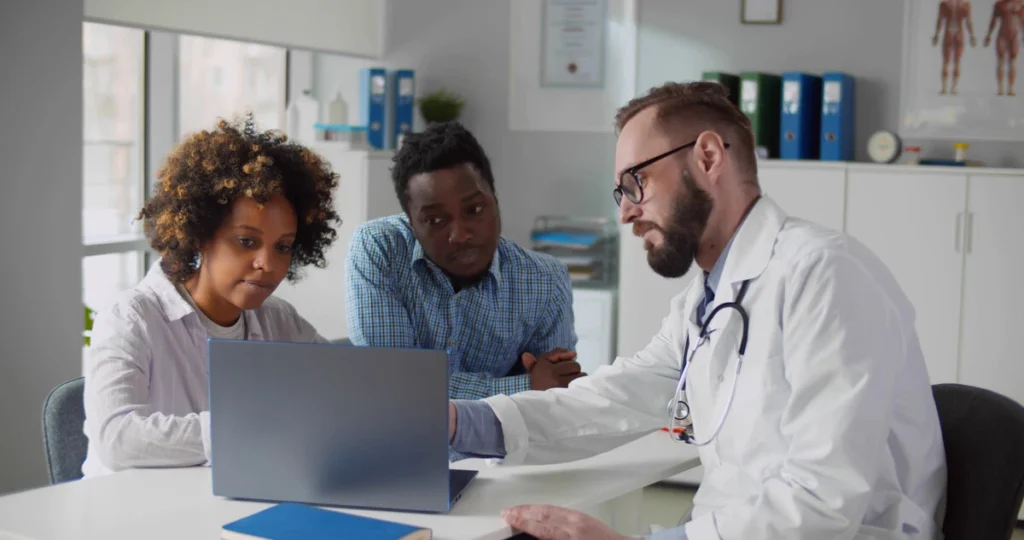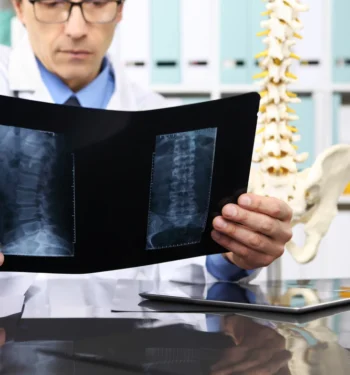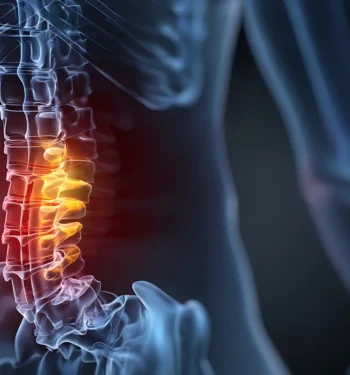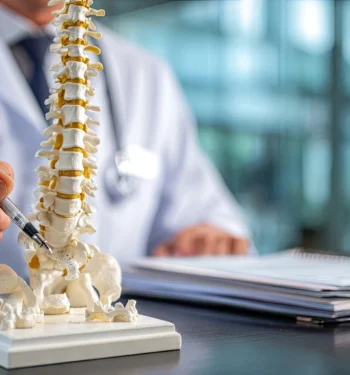
Spinal stenosis is a common condition that occurs when the spinal canal narrows, putting pressure on the spinal cord and nerves. Often stemming from age-related wear and tear (though arthritis, herniated discs, and thickened ligaments are also common causes of spinal stenosis), spinal stenosis can affect your quality of life, causing pain, numbness, and mobility challenges that worsen over time. Understanding and addressing spinal stenosis progression through proactive management is essential to maintaining both independence and comfort.
This comprehensive spinal stenosis overview will examine spinal stenosis’s various symptoms, risk factors, diagnostic methods, and available treatment options. For individuals seeking spinal stenosis treatment in Indiana, Goodman Campbell offers personalized care plans to address spinal stenosis effectively. Taking action to manage this condition can help you maintain a more active lifestyle and avoid the need for invasive treatments in the future.
How to Slow Down the Progression of Spinal Stenosis?
Addressing symptoms early is the best defense against spinal stenosis progression and plays a key role in overall spinal stenosis prevention. Regular physical activity is vital, especially low-impact exercises such as walking, swimming, or cycling, which strengthen muscles supporting the spine and improve flexibility. These activities can assist in maintaining proper posture and reducing spinal pressure, helping to slow down the progression of spinal stenosis. (Always consult with your spine specialist before changing your exercise routine.)
Weight management is also critical. Excess weight places stress on the spine, accelerating the narrowing process. A combination of balanced nutrition and regular exercise can make a significant difference. Additionally, managing comorbid conditions such as diabetes, arthritis, and high blood pressure can help limit inflammation and slow spinal degeneration.
Goodman Campbell specializes in creating tailored, effective care plans for spinal stenosis management. By addressing your specific symptoms and lifestyle needs, their specialists can help you take proactive steps toward managing this condition.
What Should You Stop Doing if You Have Spinal Stenosis?
Certain activities can aggravate stenosis symptoms, making it important to adopt smart spinal stenosis lifestyle changes. High-impact activities, heavy lifting, and any movements that excessively strain the spine should be limited or modified. For example, your physician might recommend that you stop running on hard surfaces or participating in contact sports. These types of changes are key to slowing the progression of spinal stenosis and reducing day-to-day discomfort.
Additionally, knowing exactly what daily activities to avoid is an essential part of practicing effective spinal stenosis safety tips. Things to avoid with cervical spinal stenosis typically include sudden neck movements, overhead lifting, or sleeping without proper neck support, all of which can worsen nerve compression and pain. Prolonged standing or walking without breaks can also aggravate symptoms. If your work requires you to stand for extended periods, taking regular breaks to sit and flex your spine can provide relief.
Posture and ergonomics are equally important. Avoid slouching, poor sleeping positions, or leaning your spine backwards for extended periods.
Seek guidance from Goodman Campbell for personalized activity recommendations to help avoid worsening symptoms.
What Is the Best Way to Live With Spinal Stenosis?
Adopting healthy habits for spinal stenosis is essential for managing the condition and improving your quality of life. Incorporating a spinal stenosis daily routine that supports your spine health within safe limits can help open the spinal canal and reduce pressure. This might include such forward-leaning activities as walking with a shopping cart or using a stationary bike.
Pain management strategies, including heat therapy, proper stretching, and careful attention to sleep positioning, can make a significant difference as well. Adjustable beds or recliners may be helpful for finding comfortable sleep postures. Additionally, physical therapy can offer structured exercises that enhance strength and flexibility.
Goodman Campbell can design a comprehensive care plan to help you with both coping with spinal stenosis and integrating these practices into your daily life. Ask us for personalized recommendations tailored to your needs.
What Is the Single Best Exercise for Spinal Stenosis?
Flexion-based exercises like walking and cycling are among the most effective forms of exercise for spinal stenosis to relieve pressure on spinal nerves. Similarly, stationary or outdoor cycling encourages a naturally flexed posture that reduces discomfort while improving cardiovascular health and lower-body strength.
Consistency and proper supervision are key. Regularly engaging in these activities can help maintain mobility and reduce symptom flare-ups, but it’s important to do so safely. Physical therapy for spinal stenosis offers the benefit of expert supervision, ensuring exercises are performed correctly and tailored to your condition. Spinal stenosis stretching routines are often included in physical therapy programs to enhance flexibility, relieve muscle tension, and support spinal alignment.
Modifications matter, especially for different types of spinal stenosis. Those with lumbar stenosis may benefit most from forward-flexion activities, while individuals with cervical stenosis should avoid neck strain and focus on low-impact movements that don’t compromise cervical alignment.
Before starting any new exercise routine, talk to your doctor at Goodman Campbell. Our care team can help you develop a personalized, supervised plan that supports your mobility goals while minimizing risk and discomfort.
How Do You Fix Spinal Stenosis Without Surgery?
Nonsurgical spinal stenosis treatment can be highly effective for managing symptoms and improving daily function. Conservative spinal stenosis treatment options include physical therapy and low-impact exercise programs, which help build strength and improve mobility. Over-the-counter medications can ease discomfort and reduce inflammation.
Lifestyle changes, such as improving posture, staying active, and managing weight, also support long-term relief. Your care team might also recommend assistive devices and orthotics, including back braces or shoe inserts, to improve alignment and stability. Preventative care is key to stop spinal stenosis from progressing further.
If you’re exploring alternatives to spinal stenosis surgery, talk to your doctor at Goodman Campbell. Our team offers personalized, nonsurgical care plans to help you stay active and avoid invasive procedures when appropriate.
What Is the Best Treatment for Spinal Stenosis at L4 and L5?
Lumbar spinal stenosis, including spinal stenosis at L4 and L5, can often be managed with nonsurgical treatments, though surgery may be necessary for more advanced cases. Medications and targeted injections from an interventional pain management specialist play important roles in managing spinal stenosis pain, while physical therapy supports mobility and strength.
At Goodman Campbell, we create personalized care plans that address your unique needs, whether you need spinal stenosis L4 L5 treatment, broader lower back stenosis solutions, or ongoing targeted stenosis therapy. Contact us today to get expert guidance and support.
What Is the Newest Treatment for Spinal Stenosis?
While medical advances continue to evolve, the newest treatment for spinal stenosis is most readily an advanced minimally invasive surgery or injection with image-guided delivery for improved, targeted relief. Minimally invasive surgical options for spinal stenosis offer shorter recovery times and reduced risk of complications compared to traditional surgical procedures, making them a strong choice for eligible patients.
At the same time, innovative spinal stenosis therapies guided by a physical therapist with a focus and training on spine health and neurological conditions are also gaining ground. Goodman Campbell remains at the forefront of spinal stenosis technology, offering expert insight and consultation into the most effective solutions for your condition.
What Are the Worst Symptoms of Spinal Stenosis?
Severe spinal stenosis signs can include chronic pain, significant numbness, loss of bladder or bowel control, or even paralysis in severe cases. These represent some of the worst symptoms of spinal stenosis and require immediate medical attention. Prompt care helps reduce the risk of serious spinal stenosis complications and improves long-term outcomes. Seek immediate help from Goodman Campbell for acute symptoms and expert guidance on timely intervention.
What Are the Final Stages of Spinal Stenosis?
The final stages of spinal stenosis may involve worsening symptoms such as severe nerve pain, numbness, or even paralysis. Patients often face serious mobility limitations, increased risk of falls, and growing dependence on caregivers. Managing persistent discomfort becomes a priority, with specialized strategies for chronic pain management. As the spinal stenosis prognosis becomes more complex, seeking long-term support may be valuable. For help navigating complications of spinal stenosis, consult Goodman Campbell for expert evaluation and advanced care planning.
Can Spinal Stenosis Kill You?
Spinal stenosis is rarely fatal, but when combined with related health issues and untreated progression, the answer to “Can spinal stenosis kill you?” can be complicated. Severe compression of the spinal cord may increase the chances that a person takes a bad fall or even becomes paralyzed, serious spinal stenosis risks that can indirectly impact life expectancy. In extreme cases, spinal stenosis fatal complications may arise from infections, immobility, or undiagnosed neurological damage. An accurate spinal stenosis diagnosis and routine monitoring are essential. Ask Goodman Campbell about personalized risk management strategies to stay ahead of potential complications.
Conclusion: Partner With Goodman Campbell to Manage Spinal Stenosis Progression
Managing spinal stenosis care requires early intervention, lifestyle adjustments, and expert guidance. A personalized treatment plan helps preserve quality of life while addressing the unique challenges of the condition. Whether you’re dealing with mild discomfort or more advanced symptoms, Goodman Campbell offers comprehensive support focused on maintaining your independence and comfort. Reach out to Goodman Campbell today to get started.



